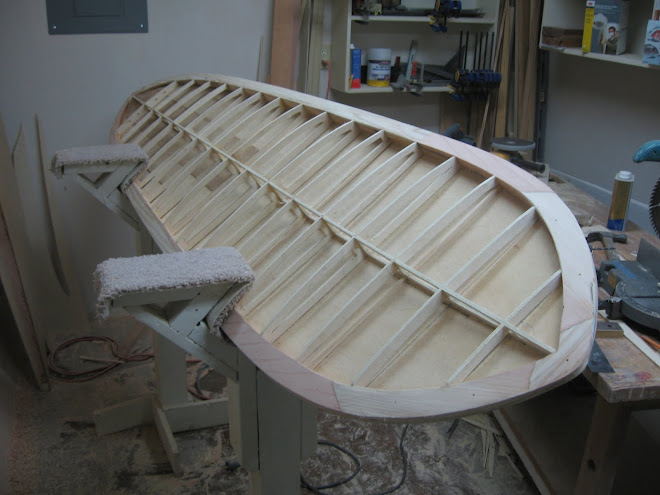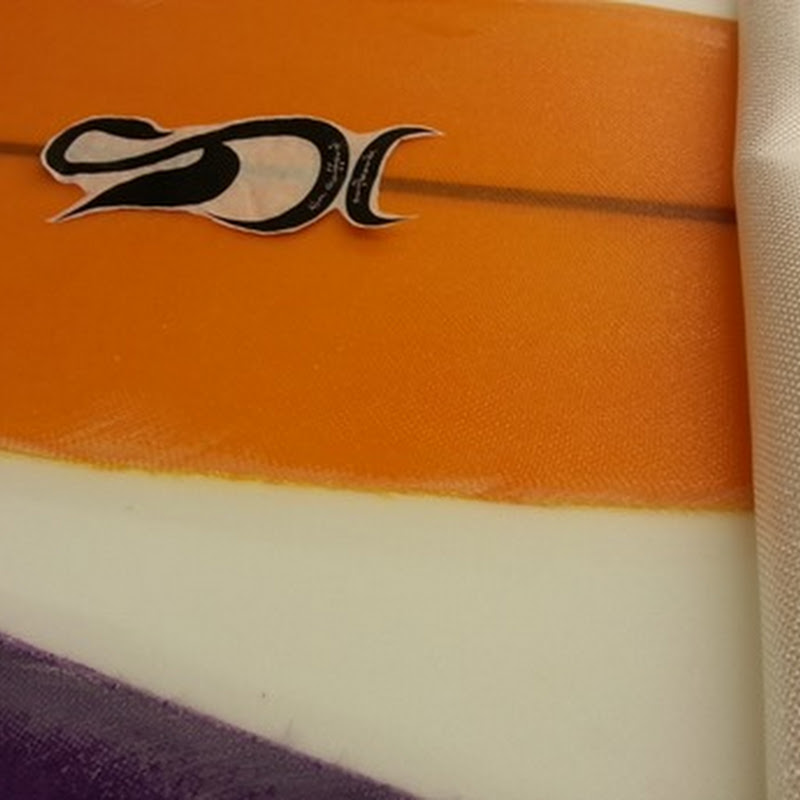
Someone asked me recently, What is the difference between a styrofoam and a hollow wooden surfboard? That's a bigger question than I could answer in just a few paragraphs, so I just put some of my random thoughts on the subject together.
Surfboards have been made primarily out of foam and fiberglass, since about the 1950's. Its light, strong (enough), easy to shape, looks good, and because its the acceptible norm, its easy to sell.
But, its a polluting synthetic petrochemical by-product, and in reality only lasts a year or so under normal conditions.
Wood, on the other hand, is a natural product, non polluting, and a properly maintained wood surfboard will outlast a styrofoam board ten to one, or more.
But, hollow wood surfboards are heavy - heavier anyway - say 10-17 lbs. compared to 7-12. The new EPS foam boards with epoxy resin are getting down in the 5 lb. range. Awesome how light they make 'em. But, they're fragile as heck. (Now, there are guys like Brad Tucker of Wood Surfboard Supply, Inc., shown in the picture, who are building with balsa and paulownia and are getting their boards very close to the weight of foam boards.)
Pro surfers don't care how fragile a board is - they get their boards for free. And the board manufacturers like surfboards to be fragile, because the more fragile they are, the quicker you'll have to buy a replacement. Environmental responsibility is not high on the corporate surfboard manufacturer's list. And most surfers want to ride what the pro surfers are riding, because, after all, the corporate advertising is telling us constantly that we have to mimic the sports superstars in order to be "cool". Now, no surfboard (that I'm aware of) is 100% "green", but longevity of the product is a huge factor in how environmentally responsible it is. If surfboards last 10 times longer, that's 1/10th the pollution, landfill waste, etc. You see the difference it makes.
So that's kind of the deal. Wood is natural, longer lasting, non-polluting, but heavier, and less 'corporate-advertising cool'. Surfing wise, I don't really see a noticeable difference in the water. After all, when you combine weight of surfer and board together, the few pounds difference is a small percentage of the overall picture.
Oh yeah, and hollow wood surfboards take at least ten times as long and are ten times harder to make. You could shape a foam surfboard blank and glass it with UV resin and have it in the water the next day. A good shaper turns a foam blank into a surfboard in a couple hours. A wood board is built over a period of weeks, as a general rule. By a backyard builder, way off the corporate grid.
And I might mention here, CNC has taken over a large portion of the corporate manufactured surfboard market, as well. Foam surfboards are now being shaped by computers, they just sand 'em and glass 'em and stick a popular logo on and send 'em on down the assembly line, knowing the kid's'll buy 'em up!
And I might as well mention also, the foriegn labor syndrome has made huge inroads into the American surfboard industry. Workers in impoverished areas are paid $2/hr (or less, depending on who you believe) to work 12 hours a day, 7 days a week, one day off a month, room and board provided by the mf'r. (rent and meals is deducted from their paycheck). 12 hours a day these guys spend in a little cubicle making surfboards that they haven't got a clue how to ride or probably even what they're for, day in and day out, sunup to sundown, for subsistence wages. Ship 'em off the U.S. with any logo you want "Malibu Surfboards", "Aloha Surfboards", you name it.
Surfboards have been made primarily out of foam and fiberglass, since about the 1950's. Its light, strong (enough), easy to shape, looks good, and because its the acceptible norm, its easy to sell.
But, its a polluting synthetic petrochemical by-product, and in reality only lasts a year or so under normal conditions.
Wood, on the other hand, is a natural product, non polluting, and a properly maintained wood surfboard will outlast a styrofoam board ten to one, or more.
But, hollow wood surfboards are heavy - heavier anyway - say 10-17 lbs. compared to 7-12. The new EPS foam boards with epoxy resin are getting down in the 5 lb. range. Awesome how light they make 'em. But, they're fragile as heck. (Now, there are guys like Brad Tucker of Wood Surfboard Supply, Inc., shown in the picture, who are building with balsa and paulownia and are getting their boards very close to the weight of foam boards.)
Pro surfers don't care how fragile a board is - they get their boards for free. And the board manufacturers like surfboards to be fragile, because the more fragile they are, the quicker you'll have to buy a replacement. Environmental responsibility is not high on the corporate surfboard manufacturer's list. And most surfers want to ride what the pro surfers are riding, because, after all, the corporate advertising is telling us constantly that we have to mimic the sports superstars in order to be "cool". Now, no surfboard (that I'm aware of) is 100% "green", but longevity of the product is a huge factor in how environmentally responsible it is. If surfboards last 10 times longer, that's 1/10th the pollution, landfill waste, etc. You see the difference it makes.
So that's kind of the deal. Wood is natural, longer lasting, non-polluting, but heavier, and less 'corporate-advertising cool'. Surfing wise, I don't really see a noticeable difference in the water. After all, when you combine weight of surfer and board together, the few pounds difference is a small percentage of the overall picture.
Oh yeah, and hollow wood surfboards take at least ten times as long and are ten times harder to make. You could shape a foam surfboard blank and glass it with UV resin and have it in the water the next day. A good shaper turns a foam blank into a surfboard in a couple hours. A wood board is built over a period of weeks, as a general rule. By a backyard builder, way off the corporate grid.
And I might mention here, CNC has taken over a large portion of the corporate manufactured surfboard market, as well. Foam surfboards are now being shaped by computers, they just sand 'em and glass 'em and stick a popular logo on and send 'em on down the assembly line, knowing the kid's'll buy 'em up!
And I might as well mention also, the foriegn labor syndrome has made huge inroads into the American surfboard industry. Workers in impoverished areas are paid $2/hr (or less, depending on who you believe) to work 12 hours a day, 7 days a week, one day off a month, room and board provided by the mf'r. (rent and meals is deducted from their paycheck). 12 hours a day these guys spend in a little cubicle making surfboards that they haven't got a clue how to ride or probably even what they're for, day in and day out, sunup to sundown, for subsistence wages. Ship 'em off the U.S. with any logo you want "Malibu Surfboards", "Aloha Surfboards", you name it.


































.jpg)












No comments:
Post a Comment